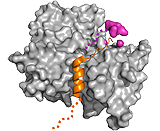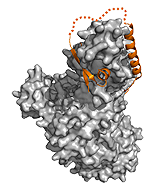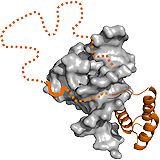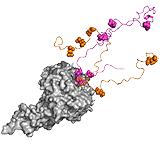|

polymorphic

clamp

flanking

random
|
|

Fuzzy complexes are protein complexes, where structural ambiguity or multiplicity exists and is required for biological function.Alteration, truncation or removal of conformationally heterogeneous regions impacts the activity of the corresponding complex.
Fuzzy regions remain highly dynamic or adopt multiple conformations in the complex. Via weak, transient interactions they could modulate the conformational equilibrium or flexibility of the binding interface, or compete with the partner. Fuzzy regions could also facilitate interactions of globular domains. Their post-translational modifications or alternative isoforms are important to fine-tune affinity or specificity of the complex.
Fuzzy complexes in cellular networks
Fuzzy complexes are extensively utilized to regulate the output of signaling networks. Depending on the cellular context or physiological conditions, fuzzy regions can adopt different forms and thus modulate the activity of or communication between protein complexes, which are involved in the pathway.
Tissue-specific alternative splicing for example, can generate isoforms, which differ in an interaction motif that is embedded in a fuzzy region. The inclusion of such segment was shown to rewire protein interaction networks in different tissues.
Fuzzy regions also enable ultra-sensitive response to signals, e.g. to increasing Ca2+ ion concentration. Gradual phosphorylation of fuzzy regions in e.g. Ets1 or Sic1 attenuates the threshold for binding.
|
Key references:
P. Tompa and M Fuxreiter (2008) Fuzzy complexes: polymorphism and structural disorder in protein–protein interactions.Trends in Biochem. Sci 33, 2-8. abstract
M Fuxreiter, P Tompa, I Simon, VN Uversky, JC Hansen, F Asturias (2008) Malleable machines take shape in eukaryotic transcription regulation. Nat Chem Biol 4, 728-737. abstract
M.Fuxreiter, I. Simon, S. Bondos (2011) Dynamic protein-DNA recognition: beyond what can be seen. Trends in Biochem Sci 36, 415-423. abstract
M Fuxreiter (2012) Fuzziness: linking regulation to protein dynamics. Mol Biosystems 8, 168-177. abstract
Monika Fuxreiter and Peter Tompa (Eds) Fuzziness: Structural disorder in protein complexes, Landes Bioscience/Springer, Austin, NY 2011 abstract1, 2



